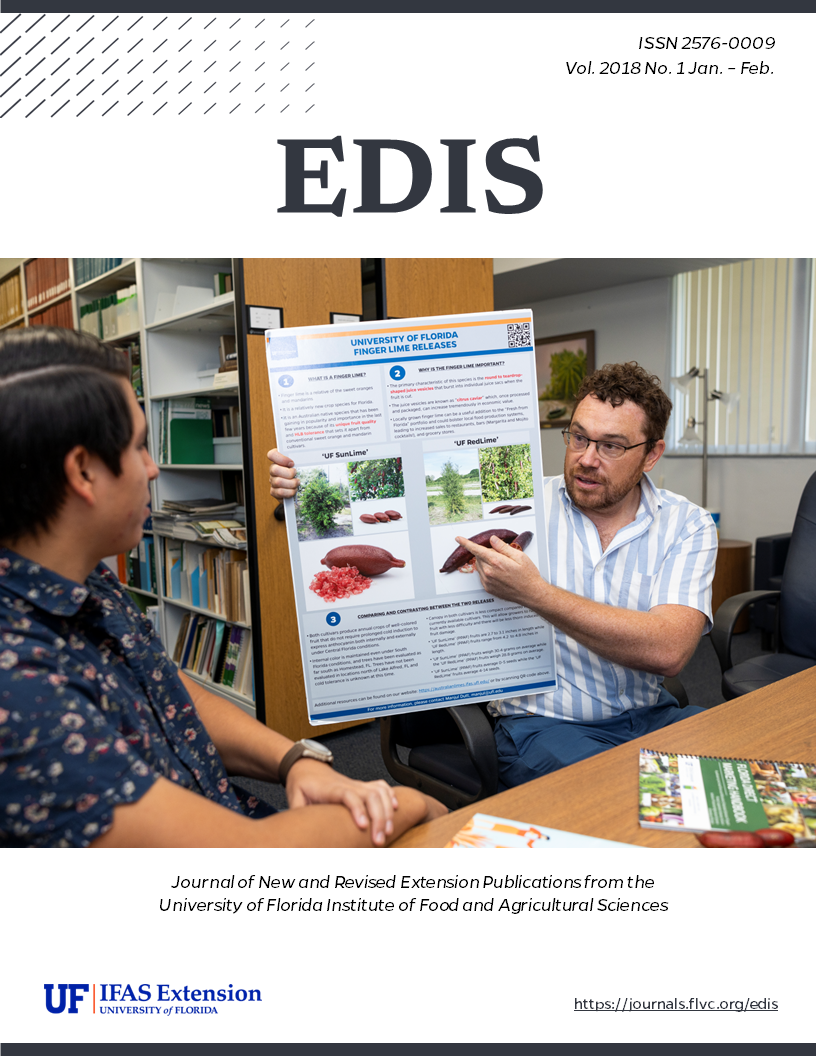Abstract
This fact sheet supercedes EENY-266/IN545 (originally published as DPI Entomology Circular 217), by H. H. Weems. Jr.
References
Břízová R, Mendonca AL, Vanickova L, Silva CED, Tomcala A, Paranhos BAJ, Dias VS, Joachim-Bravo IS, Hoskovec M, Kalinova B, Nascimento RRD, da Silva CE, do Nascimento RR. 2013. Pheromone analyses of the Anastrepha fraterculus (Diptera: Tephritidae) cryptic species complex. Florida Entomologist 96: 1107-1115. https://doi.org/10.1653/024.096.0351
Cáceres C, Segura DF, Vera MT, Wornoayporn V, Cladera JL, Teal P, Sapountzis P, Bourtzis K, Zacharopoulou A, Robinson AS. 2009. Incipient speciation revealed in Anastrepha fraterculus (Diptera: Tephritidae) by studies on mating compatibility, sex pheromones, hybridization, and cytology. Biological Journal of the Linnean Society 97: 152-165. https://doi.org/10.1111/j.1095-8312.2008.01193.x
Canal NA, Hernández-Ortiz V, Tigrero SJO, Selivon D. 2015. Morphometric study of third-instar larvae from five morphotypes of the Anastrepha fraterculus cryptic species complex (Diptera, Tephritidae). In De Meyer M, Clarke AR, Vera MT, Hendrichs J (Eds) Resolution of Cryptic Species Complexes of Tephritid Pests to Enhance SIT Application and Facilitate International Trade. ZooKeys 540: 41-59. https://doi.org/10.3897/zookeys.540.6012
Devescovi F, Abraham S, Roriz AKP, Nolazco N, Castaneda R, Tadeo E, Cáceres C, Segura DF, Teresa Vera M, Joachim-Bravo IS, Canal N, Rull J. 2014. Ongoing speciation within the Anastrepha fraterculus cryptic species complex: The case of the Andean morphotype. Entomologia Experimentalis Et Applicata 152: 238-247. https://doi.org/10.1111/eea.12219
Dias VS, Silva JG, Lima KM, Petitinga CSCD, Hernández-Ortiz V, Laumann RA, Paranhos BJ, Uramoto K, Zucchi RA, Joaquim-Bravo IS. 2016. An integrative multidisciplinary approach to understanding cryptic divergence in Brazilian species of the Anastrepha fraterculus complex (Diptera: Tephritidae). Biological Journal of the Linnean Society 117: 725-746. https://doi.org/10.1111/bij.12712
Greene CT. 1934. A revision of the genus Anastrepha based on a study of the wings and on the length of the ovipositor sheath (Diptera: Trypetidae). Proceedings of the Entomological Society of Washington 36: 127-179.
Hendrichs J, Vera MT, De Meyer M, Clarke AR. 2015. Resolving cryptic species complexes of major tephritid pests. In De Meyer M, Clarke AR, Vera MT, Hendrichs J (Eds) Resolution of Cryptic Species Complexes of Tephritid Pests to Enhance SIT Application and Facilitate International Trade. ZooKeys 540: 5-39. https://doi.org/10.3897/zookeys.540.9656
Hernández-Ortiz V, Bartolucci AF, Morales-Valles P, Frias D, Selivon D. 2012. Cryptic species of the Anastrepha fraterculus Complex (Diptera: Tephritidae): A multivariate approach for the recognition of South American morphotypes. Annals of the Entomological Society of America 105: 305-318. https://doi.org/10.1603/AN11123
Hernández-Ortiz V, Canal NA, Tigrero Salas JO, RuÃz-Hurtado FM, Dzul-Cauich JF. 2015. Taxonomy and phenotypic relationships of the Anastrepha fraterculus complex in the Mesoamerican and Pacific Neotropical dominions (Diptera, Tephritidae). De Meyer M, Clarke AR, Vera MT, Hendrichs J (Eds) Resolution of Cryptic Species Complexes of Tephritid Pests to Enhance SIT Application and Facilitate International Trade. ZooKeys 540: 95-124.
Hernández-Ortiz V, Gomez-Anaya JA, Sanchez A, McPheron BA, Aluja M. 2004. Morphometric analysis of Mexican and South American populations of the Anastrepha fraterculus complex (Diptera: Tephritidae) and recognition of a distinct Mexican morphotype. Bulletin of Entomological Research 94: 487-499. https://doi.org/10.1079/BER2004325
Lance D, McInnis D. 2005. Biological basis of the sterile insect technique. In Dyck VA, Hendrichs J, Robinson A. (eds) Sterile Insect Technique: principles and practice in area-wide integrated pest management. Springer, Dordrecht, pp 69-94. https://doi.org/10.1007/1-4020-4051-2_3
Morgante JS, Malavasi A, Bush GL. 1980. Biochemical systematics and evolutionary relationships of Neotropical Anastrepha. Annals of the Entomological Society of America 73: 622-630. https://doi.org/10.1093/aesa/73.6.622
Murillo T, Jiron LF. 1994. Egg morphology of Anastrepha obliqua and some comparative aspects with eggs of Anastrepha fraterculus (Diptera, Tephritidae). Florida Entomologist 77: 342-348. https://doi.org/10.2307/3496104
Nieuwenhove GAV, Ovruski SM. 2011. Influence of Anastrepha fraterculus (Diptera: Tephritidae) larval instars on the production of (Hymenoptera: Braconidae) progeny and their sex ratio. Florida Entomologist 94: 863-868. https://doi.org/10.1653/024.094.0421
Rull J, Abraham S, Kovaleski A, Segura DF, Mendoza M, Clara Liendo M, Teresa Vera M. 2013. Evolution of pre-zygotic and post-zygotic barriers to gene flow among three cryptic species within the Anastrepha fraterculus complex. Entomologia Experimentalis Et Applicata 148: 213-222. https://doi.org/10.1111/eea.12094
Selivon D, Morgante JS, Perondini ALP. 1997. Egg size, yolk mass extrusion and hatching behavior in two cryptic species of Anastrepha fraterculus (Wiedemann) (Diptera, Tephritidae). Brazilian Journal of Genetics 20: 587-594. https://doi.org/10.1590/S0100-84551997000400006
Selivon D, Perondini ALP, Morgante JS. 2005. A genetic-morphological characterization of two cryptic species of the Anastrepha fraterculus complex (Diptera: Tephritidae). Annals of the Entomological Society of America 98: 367-381. https://doi.org/10.1603/0013-8746(2005)098[0367:AGCOTC]2.0.CO;2
Selivon D, Perondini ALP. 1998. Eggshell morphology in two cryptic species of the Anastrepha fraterculus complex (Diptera: Tephritidae). Annals of the Entomological Society of America 91: 473-478. https://doi.org/10.1093/aesa/91.4.473
Smith-Caldas MRB, McPheron BA, Silva JG, Zucchi RA. 2001. Phylogenetic relationships among species of the fraterculus group (Anastrepha: Diptera: Tephritidae) inferred from DNA sequences of mitochondrial cytochrome oxidase I. Neotropical Entomology 30: 565-573. https://doi.org/10.1590/S1519-566X2001000400009
Steck GJ. 1991. Biochemical systematics and population genetic-structure of Anastrepha fraterculus and related species (Diptera: Tephritidae). Annals of the Entomological Society of America 84: 10-28. https://doi.org/10.1093/aesa/84.1.10
Stone A. 1942. The fruit flies of the genus Anastrepha. U.S. Department of Agriculture Miscellaneous Publication 439: 1-112. Washington, D.C.
Vaníčková L, Břízová R, Pompeiano A, Ferreira LL, de Aquino NC, Tavares RF, Rodriguez LD, Mendonça AL, Canal NA, do Nascimento RR. 2015. Characterisation of the chemical profiles of Brazilian and Andean morphotypes belonging to the Anastrepha fraterculus complex (Diptera, Tephritidae). De Meyer M, Clarke AR, Vera MT, Hendrichs J (Eds) Resolution of Cryptic Species Complexes of Tephritid Pests to Enhance SIT Application and Facilitate International Trade. ZooKeys 540: 193-209.
Vera MT, Cáceres C, Wornoayporn V, Islam A, Robinson AS, De La Vega MH, Hendrichs J, Cayol JP. 2006. Mating incompatibility among populations of the South American fruit fly Anastrepha fraterculus (Diptera: Tephritidae). Annals of the Entomological Society of America 99: 387-397. https://doi.org/10.1603/0013-8746(2006)099[0387:MIAPOT]2.0.CO;2
Zucchi RA (2016) Fruit flies in Brazil - Anastrepha species their host plants and parasitoids. http://www.lea.esalq.usp.br/anastrepha (30 November 2017)
Unless otherwise specified, articles published in the EDIS journal after January 1, 2024 are licensed under a Creative Commons Attribution-NonCommercial-NoDerivs 4.0 International (CC BY-NC-ND 4.0) license.

